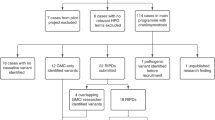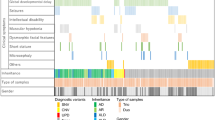Abstract
To define the range of phenotypic expression in Treacher Collins syndrome (TCS; Franceschetti–Klein syndrome), we performed mutation analysis in the TCOF1 gene in 46 patients with tentative diagnosis of TCS and evaluated the clinical data, including a scoring system. A total of 27 coding exons of TCOF1 and adjacent splice junctions were analysed by direct sequencing. In 36 patients with a clinically unequivocal diagnosis of TCS, we detected 28 pathogenic mutations, including 25 novel alterations. No mutation was identified in the remaining eight patients with unequivocal diagnosis of TCS and 10 further patients, in whom the referring diagnosis of TCS was clinically doubtful. There is no overt genotype–phenotype correlation except that conductive deafness is significantly less frequent in patients with mutations in the 3′ part of the open reading frame. Inter- and intrafamilial variation is wide. Some mutation carriers, parents of typically affected patients, are so mildly affected that the diagnosis might be overlooked clinically. This suggests that modifying factors are important for phenotypic expression. Based on these findings, minimal diagnostic criteria were defined: downward slanting palpebral fissures and hypoplasia of the zygomatic arch. The difficulties in genetic counselling, especially diagnosis of family members with a mild phenotype, are described.
Similar content being viewed by others
Log in or create a free account to read this content
Gain free access to this article, as well as selected content from this journal and more on nature.com
or
References
Treacher Collins E : Case with symmetrical congenital notches in the outer part of each lower lid and defective development of the malar bones. Trans Ophthalmol Sec UK 1900; 20: 90.
Thomson A : Notice of several cases of malformation of the external ear, together with experiments on the state of hearing in such persons. Month J Med Sci 1846; 7: 420.
Berry GA : Note on a congenital defect (?coloboma) of the lower lid. R Lond Ophthalmol Hosp Rep 1889; 12: 255–257.
Franceschetti A, Klein D : The mandibulo-facial dysostosis. A new hereditary syndrome. Acta Ophthalmol (Copenh) 1949; 27: 143–229.
Rovin S, Dachi SF, Borenstein DB, Cotter WE : Mandibulofacial dysostosis, a familial study of five generations. J Pediatr 1964; 65: 215–221.
Fazen LE, Elmore J, Nadler HL : Mandibulo-facial dysostosis (Treacher-Collins syndrome). Am J Dis Child 1967; 113: 405–410.
Connor JM, Ferguson-Smith MA : Essential medical genetics. Oxford: Blackwell Scientific, 1988.
Marres HAM, Cremers WRJ, Dixon MJ, Huygen PLM, Joosten FBM : The Treacher Collins syndrome. A clinical, radiological, and genetic linkage study on two pedigrees. Arch Otolaryngol Head Neck Surg 1995; 121: 509–514.
Dixon M : Treacher Collins syndrome. J Med Genet 1995; 32: 806–808.
Poswillo D : The pathogenesis of the Treacher Collins syndrome (mandibulofacial dysostosis). Br J Oral Surg 1975; 13: 1–26.
Gladwin AJ, Dixon J, Loftus SK et al: Treacher Collins syndrome may result from insertions, deletions or splicing mutations, which introduce a termination codon into the gene. Hum Mol Genet 1996; 5: 1533–1538.
Treacher Collins collaborative group: Positional cloning of a gene involved in the pathogenesis of Treacher Collins syndrome. Nat Genet 1996; 12: 130–136.
Edwards SJ, Gladwin AJ, Dixon MJ : The mutational spectrum in Treacher Collins syndrome reveals a predominance of mutations that create a premature termination codon. Am J Hum Genet 1997; 60: 515–524.
Wise CA, Chiang LC, Paznekas WA et al: TCOF1 gene encodes a putative nucleolar phosphoprotein that exhibits mutations in Treacher Collins syndrome throughout its coding region. Proc Natl Acad Sci 1997; 94: 3110–3115.
Splendore A, Silva EO, Alonso LG et al: High mutation detection rate in TCOF1 among Treacher Collins syndrome patients reveals clustering of mutations and 16 non-pathogenic changes. Hum Mut 2000; 16: 315–322.
Splendore A, Jabs EW, Passos-Bueno MR : Screening of TCOF1 in patients from different populations: confirmation of mutational hot spots and identification of a new missense mutation that suggests an important functional domain in the protein treacle. J Med Genet 2002; 39: 493–495.
Ellis PE, Dawson M, Dixon MJ : Mutation testing in Treacher Collins syndrome. J Orthodont 2002; 29: 293–297.
Marszalek B, Wisniewski SA, Wojcicki P, Kobus K, Trzeciak WH : Novel mutation in the 5′ splice site of exon 4 of the TCOF1 gene in the patient with Treacher Collins syndrome. Am J Med Genet 2003; 123A: 169–171.
So RB, Gonzalez B, Henning D, Dixon J, Dixon MJ, Valdez BC : Another face of the Treacher Collins syndrome (TCOF1) gene: identification of additional exons. Gene 2004; 328: 49–57.
Dixon J, Brakebusch C, Fässler R, Dixon MJ : Increased levels of apoptosis in the prefusion neural folds underlie the craniofacial disorder, Treacher Collins syndrome. Hum Mol Genet 2000; 9: 1473–1480.
Rollnick BR, Kaye CI, Nagatoshi K, Hauck W, Martin AO : Oculoauriculovertebral dysplasia and variants: phenotypic characteristics of 294 patients. Am J Med Genet 1987; 26: 361–375.
Hall BD : Choanal atresia and associated multiple anomalies. J Pediatr 1979; 95: 395–398.
Mengel MC, Königsmark BW, Berlin CI, McKusick VA : Conductive hearing loss and malformed low-set ears, as a possible recessive syndrome. J Med Genet 1969; 6: 14–21.
Courtens W, Levi S, Verbelen F, Verloes A, Vamos E : Feingold syndrome: report of a new family and review. Am J Med Genet 1997; 73: 55–60.
Zampino G, Balducci F, Mariotti P, Dickmann A, Mastroiacovo P : Growth and developmental retardation, ocular ptosis, cardiac defect, and anal atresia: confirmation of the ROCA-Wiedemann syndrome. Am J Med Genet 2000; 90: 358–360.
Wieczorek D, Altug Teber Ö, Lohmann D, Gillessen-Kaesbach G : Two brothers with Burn–McKeown syndrome. Clin Dysmorphol 2003; 12: 171–174.
Burn J, McKeown C, Wagget J, Bray R, Goodship J : New dysmorphic syndrome with choanal atresia in siblings. Clin Dysmorphol 1992; 1: 137–144.
Haworth KE, Islam I, Breen M et al: Canine TCOF1; cloning, chromosome assignment and genetic analysis in dogs with different head types. Mamm Genome 2001; 12: 622–629.
Dixon J, Hovanes K, Shiang R, Dixon MJ : Sequence analysis, identification of evolutionary conserved motifs and expression analysis of murine tcof1 provide further evidence for a potential function for the gene and its human homologue, TCOF1. Hum Mol Genet 1997; 6: 727–737.
Saba L, Meloni A, Sardu R, Travi M, Primignani P, Rosatelli MC : A novel beta-thalassemia mutation (G → A) at the initiation codon of the beta-globin gene. Hum Mutat 1992; 1: 420–422.
Cheadle JP, Belloni F, Ferrari M, Millar-Jones L, Meredith AL : A novel mutation (M1V) in the translation initiation codon of the cystic fibrosis transmembrane conductance regulator gene, in three CF chromosomes of Italian origin. Hum Mol Genet 1994; 3: 1431–1432.
Splendore A, Passos-Bueno MR, Jabs EW, van Maldergem L, Wulfsberg EA : TCOF1 mutations excluded from a role in other first and second branchial arch-related disorders. Am J Med Genet 2002; 111: 324–327.
Hall JG : Review and hypothesis: somatic mosaicism: observations related to clinical genetics. Am J Hum Genet 1998; 43: 355–363.
Hayano T, Yanagida M, Yamauchi Y, Shinkawa T, Isobe T, Takahashi N : Proteonomic analysis of human Nop56-associated pre-ribosomal ribonucleoprotein complexes : possible link between Nop56p and the nucleolar protein treacle responsible for Treacher Collins syndrome. J Biol Chem 2003; 278: 34309–34319.
Franceschetti A, Zwahlen P : Un syndrome nouveau: la dysostose mandibulofaciale. Bull Schweiz Akad Med Wiss 1944; I: 60–66.
Haga H, Yamada R, Ohnishi Y, Nakamura Y, Tanaka T : Gene-based SNP discovery as part of the Japanese millenium genome project: identification of 190562 genetic variations in the human genome. J Hum Genet 2002; 47: 605–610.
Acknowledgements
We thank the patients and their families for their cooperation and Bernhard Horsthemke for continuous support. In addition, we thank Wolfgang Engel for sending DNA and clinical data. This study was supported by grants for ÖAT (IFORES 107110-0) by the Medical Faculty, University of Essen, and from the DAAD (A0119701) and by grants from the Deutsche Forschungsgemeinschaft (WI 1440/6-1).
Author information
Authors and Affiliations
Corresponding author
Additional information
Authors 6–23 are listed alphabetically.
Rights and permissions
About this article
Cite this article
Altug Teber, Ö., Gillessen-Kaesbach, G., Fischer, S. et al. Genotyping in 46 patients with tentative diagnosis of Treacher Collins syndrome revealed unexpected phenotypic variation. Eur J Hum Genet 12, 879–890 (2004). https://doi.org/10.1038/sj.ejhg.5201260
Received:
Revised:
Accepted:
Published:
Issue date:
DOI: https://doi.org/10.1038/sj.ejhg.5201260
Keywords
This article is cited by
-
Genotype-phenotype associations in microtia: a systematic review
Orphanet Journal of Rare Diseases (2024)
-
TCOF1 pathogenic variants identified by Whole-exome sequencing in Chinese Treacher Collins syndrome families and hearing rehabilitation effect
Orphanet Journal of Rare Diseases (2019)
-
Mutation screening of Chinese Treacher Collins syndrome patients identified novel TCOF1 mutations
Molecular Genetics and Genomics (2018)
-
Living with orofacial conditions: psychological distress and quality of life in adults affected with Treacher Collins syndrome, cherubism, or oligodontia/ectodermal dysplasia—a comparative study
Quality of Life Research (2015)
-
Associations between speech features and phenotypic severity in Treacher Collins syndrome
BMC Medical Genetics (2014)



